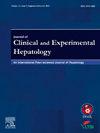Stanozolol-induced Liver Injury: A Distinctive Cholestatic Clinical and Biochemical Phenotype at Presentation
IF 3.2
Q2 GASTROENTEROLOGY & HEPATOLOGY
Journal of Clinical and Experimental Hepatology
Pub Date : 2025-01-21
DOI:10.1016/j.jceh.2025.102506
引用次数: 0
Abstract
Background & aims
The misuse of Anabolic Androgenic Steroids (AAS), including Stanozolol, for performance enhancement has emerged as a significant cause of liver damage. This study aims to elucidate the distinctive hepatotoxicity profiles induced by Stanozolol.
Methods
Eighteen individuals were prospectively evaluated by the Latin American DILI Registry from 2013 to 2023. Data regarding Stanozolol administration, symptoms onset, and clinical manifestations were collected. Comprehensive assessments including serologies, abdominal imaging, and in some cases, liver biopsies were performed to identify Stanozolol-induced liver injury and exclude other etiologies.
Results
All patients were young males aged between 19 and 48, utilizing Stanozolol for aesthetic purposes. The mean latency to symptom onset was 55 days. Predominant symptoms included jaundice and pruritus. Elevated total bilirubin levels were observed in all cases, while gamma-glutamyl transferase levels remained within or slightly above normal ranges. Concurrent use of other substances was reported in ten cases, showcasing a trend of poly-substance abuse.
Conclusions
The study identified a specific biochemical profile of Stanozolol-induced liver injury in young men using it for aesthetic purposes. The characteristic liver injury profile has marked elevation of bilirubin, mild rise in transaminases, and near-normal GGT.

斯坦诺唑尔诱导的肝损伤:一种独特的胆汁淤积临床和生化表型
背景,滥用合成代谢雄激素类固醇(AAS),包括司他唑尔,以提高成绩已经成为肝损伤的一个重要原因。本研究旨在阐明斯坦诺唑尔引起的不同肝毒性。方法2013 - 2023年拉丁美洲DILI登记处对18例患者进行前瞻性评价。收集有关司他诺唑尔给药、症状发作和临床表现的数据。进行全面评估,包括血清学、腹部成像,在某些情况下,进行肝活检,以确定司他唑罗引起的肝损伤,并排除其他病因。结果所有患者均为年轻男性,年龄在19 ~ 48岁之间。到症状发作的平均潜伏期为55天。主要症状为黄疸和瘙痒。所有病例均观察到总胆红素水平升高,而γ -谷氨酰转移酶水平保持在正常范围内或略高于正常范围。据报告,同时使用其他药物的案例有10起,显示出滥用多种药物的趋势。结论:该研究确定了司他唑罗在年轻男性中引起的肝损伤的特殊生化特征。特征性肝损伤表现为胆红素升高,转氨酶轻度升高,GGT接近正常。
本文章由计算机程序翻译,如有差异,请以英文原文为准。
求助全文
约1分钟内获得全文
求助全文
来源期刊

Journal of Clinical and Experimental Hepatology
GASTROENTEROLOGY & HEPATOLOGY-
CiteScore
4.90
自引率
16.70%
发文量
537
审稿时长
64 days
 求助内容:
求助内容: 应助结果提醒方式:
应助结果提醒方式:


